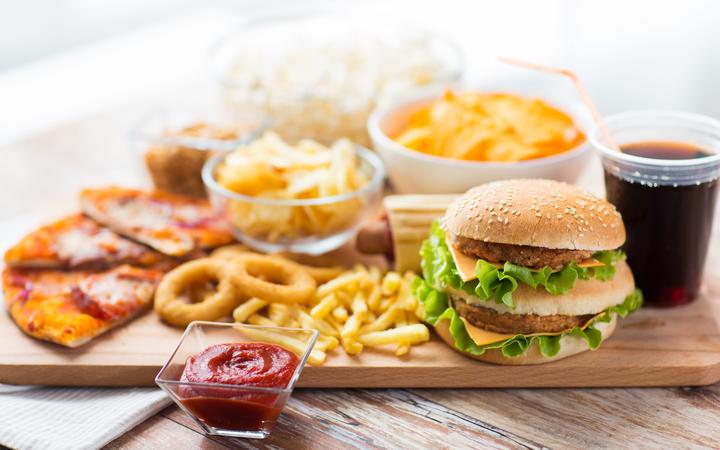Analysis – With the simple touch of a smartphone, online food delivery services conveniently offer takeaway food straight to your door.
 Online food delivery services have leveraged the pandemic to promote junk food on social media, researchers found. Photo: 123rf.com
Online food delivery services have leveraged the pandemic to promote junk food on social media, researchers found. Photo: 123rf.com
Contact-free delivery has surged in popularity as lockdowns have limited physical access to restaurants and food outlets. Industry reports suggest Australians are spending three times more on online food delivery than before the Covid-19 pandemic.
Globally, online food delivery is set to become a $US200 billion industry by 2025.
While these delivery apps provide easy access to a variety of foods, they may be harmful for our health.
Online food delivery services increase access to fast food
During January and February 2020, we analysed data from Uber Eats, the market-leading online food delivery service in Australia and New Zealand.
We focused on online food ordering in 233 suburbs in Sydney and 186 suburbs in Auckland with above-average populations of young people (aged 15-34). This age group represents the biggest consumers of online takeaway foods.
We evaluated 1074 popular food outlets available on Uber Eats across Sydney and Auckland by type and nutritional quality.
Results showed fast-food chains were the most popular food outlets. Fast-food chains accounted for 38 percent of the popular food outlets we looked at in Sydney and 54 percent in Auckland.
In Sydney, the most common fast-food chains were McDonald’s (54 stores, 8.4 percent), Subway (52 stores, 7.6 percent), Oporto (42 stores, 6.2 percent) and Domino’s (19 stores, 2.8 percent).
In Auckland, the most common fast-food chains were Subway (46 stores, 11.7 percent), McDonald’s (40 stores, 10.2 percent), Burger King (24 stores, 6.1 percent) and Hell Pizza (20 stores, 5.1 percent).
These fast-food chains were all classified in the lowest healthiness category.
When The Conversation contacted Uber Eats for comment, their spokesperson pointed to their grocery category, which “[makes] fresh fruit and vegetables more accessible for thousands of Australians”.
The spokesperson also said “quinoa, kale, bowls, brussel sprouts, edamame, acai, kombucha, hummus, poke and brown rice” have all increased in popularity since June 2020. However according to our assessment, these items were not as popular or as well spruiked as the unhealthy menu items.
Independent outlets are rushing to join, but how healthy are their menus?
In Sydney, we found independent takeaway stores, like your local kebab shop or fish and chip shop, are the second most popular food outlet type (30 percent of all food outlets).
In a separate study, we analysed the menu items (13,841 in total) from 196 of Sydney’s most popular independent takeaway stores on Uber Eats. We used a classification system of 38 different food and beverage categories based on the Australian Dietary Guidelines.
We found more than 80 percent of all the menu items were discretionary or “junk” foods. A large number of menu items (42 percent) were categorised as “discretionary cereal-based mixed meals”, which includes foods such as pizzas, burgers, kebabs and pidés. Other types of junk foods could be battered fish or chicken schnitzel, and sugary drinks, among others.
 Photo: 123RF
Photo: 123RFMarketing tactics don’t help
Both these studies demonstrate the abundance of unhealthy menu items available on these platforms. This, combined with in-app marketing tactics, can hinder consumers from making healthier choices.
We found unhealthier menu items were more than twice as likely to be categorised as “most popular” than healthier options on Uber Eats. In addition, unhealthy menu items were nearly one-and-a-half times more likely to include a photo, and over six times more likely to be offered as a value bundle compared with healthier items.
In another study, we observed how online food delivery services have leveraged the pandemic to promote junk food on social media.
Our recently published digital marketing analysis on the Instagram accounts of nine online food delivery services across three regions (Australia/New Zealand, North America and the United Kingdom) found nearly 70 percent of all food advertised was junk food.
In 2020, 32 percent of posts referenced the pandemic. Most commonly, the messaging in these posts encouraged consumers to stay home and get food delivered to support local businesses.
While of course during lockdowns it’s important to stay at home, and supporting local businesses is noble, worryingly, more than 97 percent of the food items featured in Covid-19-related Instagram posts from Australia and the UK were junk foods.
Can we promote healthier choices in the digital age?
Easy access to junk foods and drinks enabled by online food delivery presents a further challenge to the increasing rates of obesity. Australian data suggest 16 percent of 18 to 24-year-olds are obese. In New Zealand, around one in three people over 15 are obese.
The World Health Organisation has acknowledged the growing impact of online food environments on people’s diet choices. For the benefit of public health, it urges collective action by food industry, governments, policy makers and researchers.
In line with the WHO, we propose the following actions:
- Include healthy online food environments in the National Obesity Strategy. This is a ten-year strategy, currently under consultation, that will guide Australia’s actions on the overweight and obesity epidemic. The public, particularly young people, have asked for supportive food environments that will enable them to make healthy food choices. This framework will be an important way to put the public health impact of online food delivery services on the agenda
- Restrict junk food advertising on social media. Online food delivery services need to be considered with the broader food industry in government policies restricting junk food advertising to young people
- Generate clear public health messaging on health and environmental impacts. Research has suggested convenient takeaway produces excessive amounts of waste. Combining the messaging may enhance potential for behaviour change
In a world disrupted by Covid-19, the way we purchase and consume food is changing. The time is ripe to shape the online food environment to promote easy access to healthy and nutritious convenience food.
This article was first published in The Conversation and draws on research by former University of Sydney Masters students Andriana Korai and Celina Wang.
The authors are: Stephanie Partridge, an NHMRC/National Heart Foundation Early Career Fellow, University of Sydney; Alice A Gibson, an NHMRC Research Fellow, Menzies Centre for Health Policy and Economics; Julie Redfern, a Professor of Public Health, University of Sydney; Rajshri Roy, a senior lecturer, University of Auckland; Rebecca Raeside, a PhD candidate, research officer, University of Sydney and Sisi Jia, a PhD candidate, University of Sydney.
